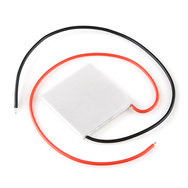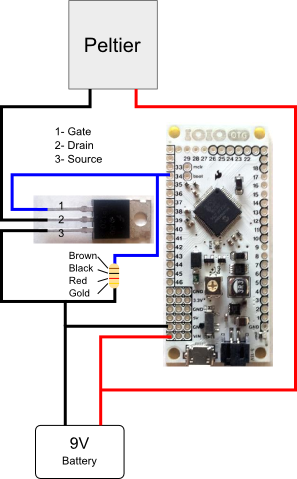Code
The code is a simple Hello IOIO with a scrollbar to control the temperature of the
Peltier. We control the temperature by using a PWM pin (I used 34) to turn the
MOSFET on and off.
public class GlassHeatMain extends IOIOActivity
implements OnSeekBarChangeListener{
private static final String TAG = "HeatGlassMain";
//Peltier controls
private final int mOutHeatPin = 34; //This pin can serve as PWM output
private final int mPWMFreq = 100; //The frequency of the PWM signal
private final int POLLING_DELAY = 150; //Wait this lont to update the signal
private final int MULTIPLIER = 100;
//HeatBar UI
private SeekBar mHeatBar;
private int mHeatValue;
private TextView mHeatText;
private long mLastChange;
This first part is the basic setup. Start a pin (34 in this case) to be a PWM
output and the variables that we will be using.
We also set up a scrollbar to control the PWM output.
@Override
public void onCreate(Bundle savedInstanceState) {
super.onCreate(savedInstanceState);
setContentView(R.layout.activity_main);
//Heat
mHeatText = (TextView) findViewById(R.id.seekBarText);
mHeatBar = (SeekBar) findViewById(R.id.seekBarHeat);
mHeatBar.setOnSeekBarChangeListener(this);
mHeatBar.setProgress(0);
}
Again, basic UI setup.
@Override
protected void onStart() {
super.onStart();
}
@Override
protected void onStop() {
super.onStop();
}
These methods control the
Activity Lifecycle
class Looper extends BaseIOIOLooper {
//Heat
private PwmOutput mHeatPWM;
@Override
protected void setup() throws ConnectionLostException {
mHeatPWM = ioio_.openPwmOutput(mOutHeatPin, mPWMFreq);
}
Here we actually tell the IOIO board to set the pint as
PWM output.
@Override
public void loop() throws ConnectionLostException {
try {
mHeatValue = mHeatBar.getProgress();
mHeatPWM.setPulseWidth(mHeatValue*MULTIPLIER);
Log.i(TAG, "setPulseWidth: "+ mHeatValue*MULTIPLIER);
Thread.sleep(100);
} catch (InterruptedException e) {
}
}
}
In the loop we constantly check for the value of the ScrollBar and send that value
to the pin to control the Peltier.
The ScrollBar value is multiplied by the MULTIPLIER. I found that I had to do this
so that the heat on the Peltier was actually noticeable within the values of the
ScrollBar
Finally the thread sleeps for 100 milliseconds before looping again.
@Override
protected IOIOLooper createIOIOLooper() {
return new Looper();
}
@Override
public void onStartTrackingTouch(SeekBar seekBar) {
mLastChange = System.currentTimeMillis();
}
Set the initial value of the MLastChange variable to the current time.
@Override
public void onProgressChanged(SeekBar seekBar, int prog, boolean fromUser) {
if (System.currentTimeMillis() - mLastChange > POLLING_DELAY) {
handleHeat(seekBar);
mLastChange = System.currentTimeMillis();
}
}
Compare the time elapsed since last check with the POLLING_DELAY variable. If the
elapsed time is more than the POLLING_DELAY then reset then go to the handleHeat()
method and reset the mLastChange variable for the next comparison.
@Override
public void onStopTrackingTouch(SeekBar seekBar) {
handleHeat(seekBar);
}
Also go to the handleHeat() method if the user has stopped touching the ScrollBar.
private void handleHeat(final SeekBar seekBar){
mHeatValue = seekBar.getProgress();
mHeatText.setText("Heat Value: " + mHeatValue*MULTIPLIER);
}
}
The method that updates the mHeatValue variable with the value on the ScrollBar
and also updates the text on the UI.
|

 images are
CC BY-NC-SA 3.0
images are
CC BY-NC-SA 3.0
